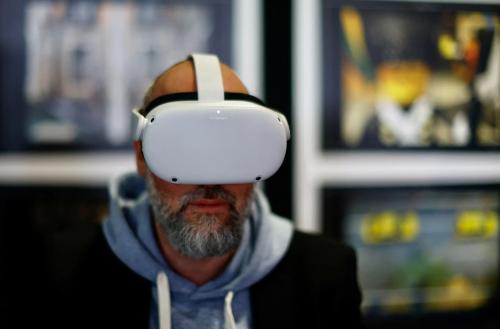Recent news that the Republican National Committee (RNC) has used an AI-generated video to criticize Joe Biden shows how likely AI is to transform our upcoming elections. Advances in digital technology provide new and faster tools for political messaging and could have a profound impact on how voters, politicians, and reporters see the candidates and the campaign. We are no longer talking about photoshopping small tweaks to how a person looks or putting someone’s head on another individual’s body, but rather moving to an era where wholesale digital creation and dissemination are going to take place. Through templates that are easy and inexpensive to use, we are going to face a Wild West of campaign claims and counter-claims, with limited ability to distinguish fake from real material and uncertainty regarding how these appeals will affect the election.
Instant responses
Politicians can use generative AI to respond instantly to campaign developments. In the RNC’s case, it released its new video right after Biden’s reelection announcement. It did not appear the party went through extensive shooting, editing, or review. Rather, it simply asked the tool to put together a video that detailed a dystopian U.S. future if Biden were reelected.
In the coming year, response times may drop to minutes, not hours or days. AI can scan the internet, think about strategy, and come up with a hard-hitting appeal. That could be a speech, press release, picture, joke, or video touting the benefits of one candidate over another. AI provides an inexpensive way to generate instant responses without having to rely on highly-paid consultants or expert videographers.
Precise message targeting
AI enables very precise audience targeting, which is crucial in political campaigns. Candidates don’t want to waste money on those who already support or oppose their campaign. Rather, they want to target the small number of swing voters who will decide the actual election or suppress the turnout of those supporting the other campaign. With our high rates of political polarization, only a small percentage of the electorate says they are undecided at the presidential level. According to an April, 2023 Emerson College survey, only six percent of voters are undecided with 43 percent supporting Biden, 41 percent favoring Trump, and 10 percent preferring another candidate.
The closeness of the general election indicates ways in which AI can help candidates. Using microdata from commercial data brokers who have detailed information of people’s reading, viewing, purchasing, and political behavior, campaigners will be able to fine-tune their targeting, reach those who have not yet made up their minds, and give them the exact message that will help them reach their final decisions. By analyzing this material in real-time, AI will enable campaigners to go after specific voting blocs with appeals that nudge them around particular policies and partisan opinions.
Democratizing disinformation
AI likely will democratize disinformation by bringing sophisticated tools to the average person interested in promoting their preferred candidates as well. People no longer must be coding experts or video wizards to generate text, images, video, or programs. They don’t necessarily have to work for a troll farm to create havoc with the opposition. They can simply use advanced technologies to spread the messages they want. In that sense, anyone can become a political content creator and seek to sway voters or the media.
With emotions running intensely in a high-stakes election, many voters also may have incentives to spread false information designed to undermine the opposition. If someone can create noise, build uncertainty, or develop false narratives, that could be an effective way to sway voters and win the race. Since the 2024 presidential election may come down to tens of thousands of voters in a few states, anything that can nudge people in one direction or another could end up being decisive.
New technologies enable people to monetize discontent and make money off other people’s fears, anxieties, or anger. Generative AI can develop messages aimed at those upset with immigration, the economy, abortion policy, critical race theory, transgender issues, or the Ukraine war. It can also create messages that take advantage of social and political discontent, and use AI as a major engagement and persuasion tool.
Few guardrails or disclosure requirements
What makes the coming year particularly worrisome is the lack of guardrails or disclosure requirements that protect voters against fake news, disinformation, or false narratives. Since campaign speech is protected speech, candidates can say and do pretty much whatever they want without risk of legal reprisal. Even if their claims are patently false, judges long have upheld candidate rights to speak freely and falsely. Defamation lawsuits of the type seen this year with Fox News are rare in regard to political candidates and work only with well-resourced litigants.
Neither individuals nor organizations are required to disclose that they used generative AI to manufacture videos or develop specific campaign appeals. The RNC deserves kudos for its voluntary disclosure of its recent commercial, but there is little reason to think that will become the norm. It is more likely that people will use new content tools without any public disclosure and it will be impossible for voters to distinguish real from fake appeals.






Commentary
How AI will transform the 2024 elections
Wednesday, May 3, 2023